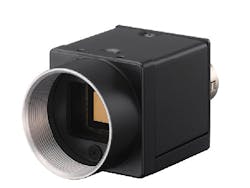Camera design: Sony marks transition from CCD to CMOS with new camera release
Sony Europe's Image Sensing Solutions (The Heights, Brooklands, Surrey, UK;www.image-sensing-solutions.eu) has announced a new series of SXGA camera modules which are positioned to enable users to move from CCD to global shutter CMOS image sensor.
The first camera available in the series is the XCG-CG160, which is available in color and monochrome, and is based on the 1/3" IMX273 global shutter CMOS image sensor-a sensor Sony notes as an ideal replacement for cameras using the popular ICX445 CCD sensor.
A suitablereplacement for the popular ICX445, the SXGA series camera modules from Sony are positioned as a low-disruption way to move to digital.
Matt Swinney, Senior Marketing Manager, Image Sensing Solutions, at Sony Imaging Sensing Solutions commented on the new camera and the rise of CMOS technology.
"The company strategy has lent itself to Sony being able to get back involved in the digital area, and Pregius technology has allowed us to come to a place where we can surpass CCD technology," he said. "Camera wise, the focus here is providing a migration path from Sony CCD users into the new CMOS age. Our new model is very much in the mold of giving customers an option to move from the old ICX445 machine vision camera"
Part of the desire to develop cameras based on the latest Pregius sensors is to offer a complete camera, instead of just offering the sensor to competitors, noted Swinney.
"Sony knows how to make cameras, and not just sensors. Many competitors are specifically in machine vision, Sony has the benefit of fulling understanding how to maximize the benefit of the sensor. This release is also an extension of our desire to take our customers to the next step. Sony does business with customers for a very long time, and we are getting to the natural life cycle of CCD technology."
"There are other companies that offer alternatives," he continued," but we now have an opportunity to continue the journey with many customers across the world."
The IMX273 is a 1.6 MPixel sensor that can achieve a frame rate of 75 fps via the camera's GigE interface. The C-Mount camera's features include defect-pixel correction, shading correction with both peak and average detection and area gain to automatically adjust for the target object.
The module also supports 2x2 multi-region of interest, flip, and binning. Additionally, Sony's Firmware v1.1 is is certified by Cognex VisionPro and is GigE Version 2.0 compliant; allowing both hard and software triggering, with the module able to act as a both an IEEE1588 (PTP) master and slave. The firmware uniquely allows for up to 16 action cue commands, plus acquisition sequence scheduling and GPO control, according to the company.
Black and white models are available immediately and color models will be available in December, while USB 3.0 models-Sony's first-are scheduled to enter mass production by Q1 2018. In terms of why Sony chose to develop USB 3.0 cameras, the company indicated that it is responding to the frame rate requirements and other desires of customers, and that they are "exploring further technological improvements that can add value."
"You will hear more from us, both camera and sensor wise, as we try to position ourselves as a company that sets the bar," said Swinney. "We are looking to reinforce the fact that, as a camera manufacturer, we have this heritage we can leverage into machine vision.
View the new camera here:http://bit.ly/VSD-SONYCAM.

